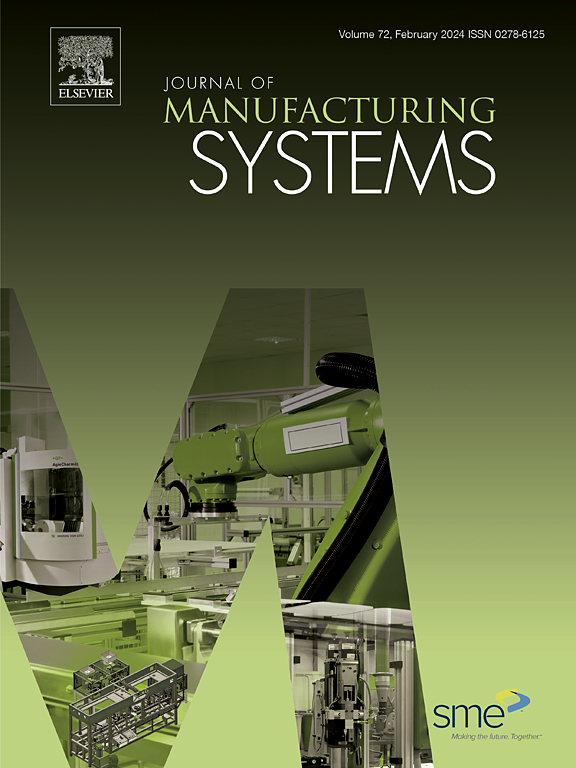数字孪生驱动的多机器人协同制造:进展、挑战和未来方向
IF 14.2
1区 工程技术
Q1 ENGINEERING, INDUSTRIAL
引用次数: 0
摘要
为未来工厂设想的多机器人系统将促进处理复杂任务和实现最佳机器人操作的进步和能力。然而,现有的多机器人系统存在集成复杂、协调控制困难、可扩展性差、灵活性差等问题,远远不能实现自适应高效的多机器人协同制造。数字孪生技术通过物理和虚拟空间的实时交互和迭代优化,改善了MRCM中的可视化、一致性和时空协作。尽管有这些改进,诸如未开发的建模能力、不确定的协作策略和有限的适用性等障碍阻碍了MRCM的广泛集成。针对这些需求,本研究对数字孪生驱动MRCM的基本概念、系统架构和使能技术进行了全面回顾,为协同智能制造的未来工作提供了前瞻性愿景。随着传感器和计算能力的发展,机器人智能正在向多机器人协作发展,包括感知协作、认知协作和行为协作。数字孪生在多机器人协作中起着关键的支持作用,并且在MRCM过程的不同阶段详细阐述了体系结构、方法和应用程序。本文还指出了当前面临的挑战和未来的研究方向。它鼓励学术界和工业界的利益相关者将最先进的人工智能技术更彻底地整合到多机器人数字孪生系统中,以提高生产的效率和可靠性。本文章由计算机程序翻译,如有差异,请以英文原文为准。
Multi-robot collaborative manufacturing driven by digital twins: Advancements, challenges, and future directions
Multi-robot systems envisioned for future factories will promote advancements and capabilities of handling complex tasks and realising optimal robotic operations. However, existing multi-robot systems face challenges such as integration complexity, difficult coordination and control, low scalability, and flexibility, and thus are far from realising adaptive and efficient multi-robot collaborative manufacturing (MRCM). Digital twin technology improves visualisation, consistency, and spatial–temporal collaboration in MRCM through real-time interaction and iterative optimisation in physical and virtual spaces. Despite these improvements, barriers such as undeveloped modelling capabilities, indeterminate collaborative strategies, and limited applicability impede widespread integration of MRCM. In response to these needs, this study provides a comprehensive review of the foundational concepts, systematic architecture, and enabling technologies of digital twin-driven MRCM, serving as a prospective vision for future work in collaborative intelligent manufacturing. With the development of sensors and computational capabilities, robot intelligence is evolving towards multi-robot collaboration, including perceptual, cognitive, and behavioural collaboration. Digital twins play a critical supporting role in multi-robot collaboration, and the architecture, methodologies, and applications are elaborated across diverse stages of MRCM processes. This paper also identifies current challenges and future research directions. It encourages academic and industrial stakeholders to integrate state-of-the-art AI technologies more thoroughly into multi-robot digital twin systems for enhanced efficiency and reliability in production.
求助全文
通过发布文献求助,成功后即可免费获取论文全文。
去求助
来源期刊

Journal of Manufacturing Systems
工程技术-工程:工业
CiteScore
23.30
自引率
13.20%
发文量
216
审稿时长
25 days
期刊介绍:
The Journal of Manufacturing Systems is dedicated to showcasing cutting-edge fundamental and applied research in manufacturing at the systems level. Encompassing products, equipment, people, information, control, and support functions, manufacturing systems play a pivotal role in the economical and competitive development, production, delivery, and total lifecycle of products, meeting market and societal needs.
With a commitment to publishing archival scholarly literature, the journal strives to advance the state of the art in manufacturing systems and foster innovation in crafting efficient, robust, and sustainable manufacturing systems. The focus extends from equipment-level considerations to the broader scope of the extended enterprise. The Journal welcomes research addressing challenges across various scales, including nano, micro, and macro-scale manufacturing, and spanning diverse sectors such as aerospace, automotive, energy, and medical device manufacturing.
 求助内容:
求助内容: 应助结果提醒方式:
应助结果提醒方式:


